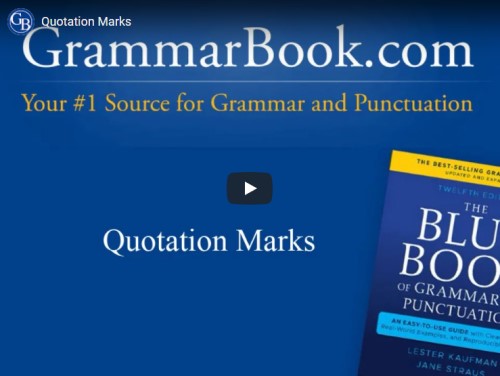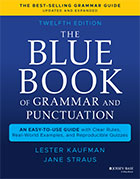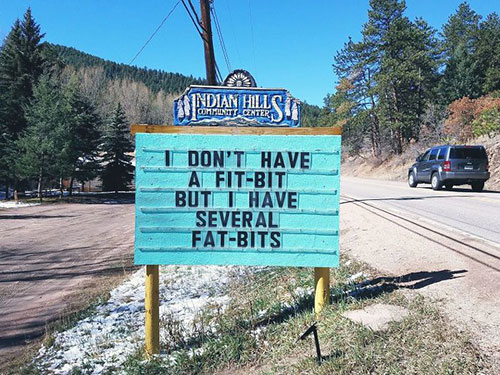|
Having trouble viewing this message? Click here to view it online.
To unsubscribe or change contact details, scroll to the bottom and follow the link.
|



|
|
Using Brackets: Changing a Quote and More
|
|
We've touched on the topic of brackets in writing at different times along the way. We also continue to receive occasional questions about their use from our readers.
With that in mind, we thought it would be a good time for a current review of brackets by gathering guidelines we've shared both on our website and in The Blue Book of Grammar and Punctuation.
(Please note that these guidelines apply to daily formal writing but are not an all-encompassing discussion of every possible aspect of them.)
When and How to Use Brackets
We will typically use brackets much less often than we do parentheses, their most closely related punctuation marks. The following are instances in which we would include brackets in our writing.
1) As additive interruptions to originally quoted material. The information in the brackets informs the reader that someone other than the original source has amended the quote to further explain, clarify, or comment on it.
Original: "Twenty boxes are too many to just pour out," the lunch assistant said.
Amended: "Twenty boxes [of the milk powder] are too many to just pour out," the lunch assistant said.
Original: "Mary waved goodbye to Bridgette."
Amended: "Mary waved goodbye to [her cousin] Bridgette." |
2) When quoting something with a spelling or grammar mistake or material presented in a confusing way. As a matter of journalistic integrity, when writers are quoting someone, the quotation should remain intact as written or spoken, even if the source is incorrect.
In these instances, we can insert the term sic (Latin for "so," "thus") in italics right after the text in question and enclose it in nonitalic brackets [sic] unless the surrounding quote is in italics (as well as possibly other content). The insertion of [sic] lets the reader know the quote is verbatim from the source, including what may be incorrect.
While we favor the treatment of sic as italicized in nonitalicized brackets, some writers might present it without italicizing the word or the brackets: [sic]. The Chicago Manual of Style favors italicizing sic in nonitalicized brackets.
Italicized sic, nonitalicized brackets: "I haven't heard something like that since World War II ended in 1946 [sic]," Joe Button Sr. said. (World War II ended in 1945.)
Quote and content all in italics: "I haven't heard something like that since World War II ended in 1946 [sic]," Joe Button Sr. said. (The brackets and sic are italicized with the rest of the quote and content.)
Nonitalicized sic, nonitalicized brackets: "I haven't heard something like that since World War II ended in 1946 [sic]," Joe Button Sr. said. |
Note that we should include [sic] after something quoted only when we intuit readers will doubt it as presented. We should not use [sic] to emphasize what appears incorrect but is intentionally applied. For example, the Chik-fil-A restaurant chain has a slogan that reads "Eat Mor Chikin" as painted by a cow. If we are quoting the slogan, inserting [sic] would be unnecessary because most people can understand it as word play.
Similarly, quoting writing or speech from different U.S. regions will often allow for variations in dialect, which could include alternate spellings, expressions, and contractions. In these cases, we should let those dialects stand unless they include evident inaccuracies.
An alternate approach to incorrect quoted material is to paraphrase it clearly and correctly rather than include it verbatim and identify it with [sic]. The Associated Press Stylebook advises this.
3) To maintain the integrity of both a quotation and the sentences others use it in.
Example
"[T]he better angels of our nature" gave a powerful ending to Lincoln's first inaugural address. (President Abraham Lincoln's memorable phrase came midsentence, so the word the was not originally capitalized.) |
4) To enclose parenthetical material that is already in parentheses.
Example: Bibliographic References
(For more on the topic, see The Blue Book of Grammar and Punctuation [2021].)
Example: Interruption Within an Interruption
Stringed instruments appear in many forms (e.g., guitar, violin, piano [see Table 2]). |
Note: We can exclude brackets if the material can be set off easily with commas without confounding meaning:
(as T. lmai, 1990, later concluded)
not
(as T. lmai [1990] later concluded) |
5) To show the pronunciation of a word.
Example
He mispronounced salmon [SAM-in]. |
|
View and comment on this
article on our website.
|
|
|

|
Pop Quiz
Place brackets where needed.
1. (For more details on brackets, see The Chicago Manual of Style 2017.)
2. He has difficulty correctly pronouncing nuclear noo-klee-er.
3. The instructions read, "Be sure to tighten it's sic lid securely."
4. There are more than 8,000 known amphibian species (almost 90% are frogs refer to illustration 3).
5. "I think I'll let Blue Angel Andrea's nickname answer that question," Liz said.
|
 |
The Blue Book of Grammar and Punctuation
by Lester Kaufman and Jane Straus |
The Authority on English Grammar! Twelfth Edition Now Available
An indispensable tool for busy professionals, teachers, students, homeschool families, editors, writers, and proofreaders.
Available in print AND as an e-Book! Over 2,000 copies are purchased every month!
To order the book, simply click the link to order the book from the GrammarBook.com website.
|
Free BONUS Quiz for You!
Friend, because you are a subscriber to the newsletter, you get access to one of the Subscribers-Only Quizzes. Click here to take a Who, Whom, Whoever, Whomever Quiz and get your scores and explanations instantly!
We will be adding many more quizzes this year to our already substantial list of them. If you have suggestions for topics we have not yet covered, please send us a message at help@grammarbook.com.
|
Hundreds of Additional Quizzes
at Your Fingertips
Subscribe now to receive hundreds of additional English usage quizzes not found anywhere else!
Teachers and Employers
Save hours of valuable time! You may assign quizzes to your students and employees and have their scores tallied, organized, and reported to you! Let GrammarBook.com take the hassle out of teaching English!
"Fun to test my skills."
"The explanations really help ... thanks!"
"I can select the quizzes to assign to my students, and then the results are reported to me automatically!"
If you think you have found an error in a quiz, please email us at help@grammarbook.com
|
Wordplay

Pop Quiz Answers
1. (For more details on brackets, see The Chicago Manual of Style [2017].)
2. He has difficulty correctly pronouncing nuclear [noo-klee-er].
3. The instructions read, "Be sure to tighten it's [sic] lid securely."
4. There are more than 8,000 known amphibian species (almost 90% are frogs [refer to illustration 3]).
5. "I think I'll let Blue Angel [Andrea's nickname] answer that question," Liz said.
|
 |
English in a Snap:
68 One-Minute English Usage Videos FREE |
Learn all about who and whom, affect and effect, subjects and verbs, adjectives and adverbs, commas, semicolons, quotation marks, and much more by just sitting back and enjoying these easy-to-follow lessons. Share them with your colleagues (and boss), children, teachers, and friends as well! Click here to watch.
|
|